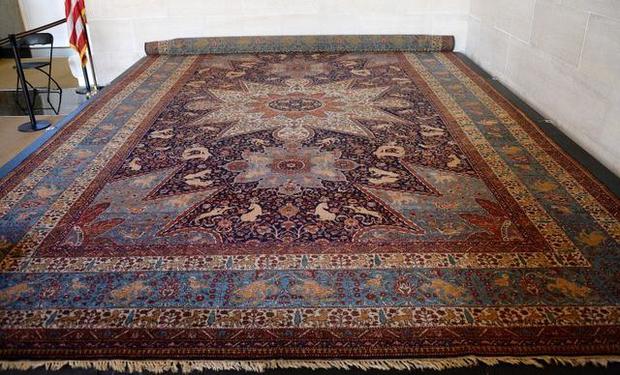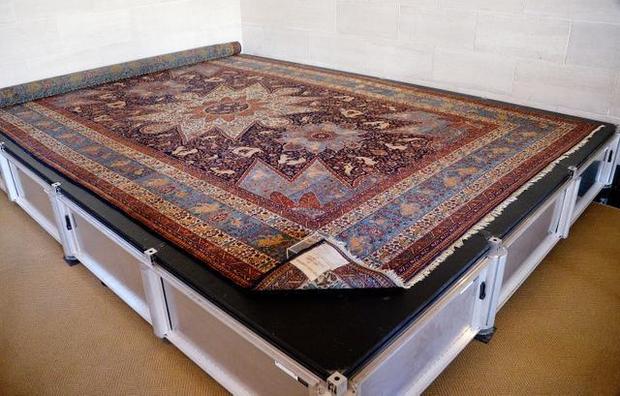Armenian Orphan Rug, symbol of tragic past, is briefly on view
WASHINGTON — Beauty born from gratitude and horror, the Armenian Orphan Rug went on long-awaited public display Tuesday at the White House Visitor Center.
The storied rug’s nearly weeklong display two blocks from the White House culminates a lobbying campaign led by California lawmakers and the Armenian-American community. It’s unveiling Tuesday morning was a history lesson, a political statement and, not least, an aesthetic revelation.
“Ahh,” said Libby Heffern, the wife of the U.S. ambassador to Armenia, John Heffern. “Magnificent.”
Heffern was among dozens of enthusiasts who flocked to see the roughly 11-foot-by-18-foot rug, partially rolled out on a platform in a corner of the visitors center. A priest from an Armenian Apostolic Church in Maryland chanted a blessing, reporters from three Armenian television networks lit up the scene and several members of Congress posed for pictures.
Nearby were two other foreign gifts to presidents: a French vase presented to President Herbert Hoover after World War I, and Japanese cherry and dogwood blossoms encased in acrylic, given to President Barack Obama.
The rug, the vase and the encased blossoms had each been presented in gratitude for U.S. generosity after international catastrophes.
“The American people should be proud to display this rug,” said Southern California resident Hratch Kozibeyokian, a director of the Armenian Rugs Society. “This carpet is a symbol of a good deed. Why should it be hidden from public display?”
Hidden away – Armenian-Americans and their myriad Capitol Hill allies believe – has until now been the rug’s fate.
The rug was intended to thank the United States for relief provided to victims of what Obama has diplomatically called the Meds Yeghern, which is Armenian for “great calamity.” The half a dozen House of Representatives members who convened Tuesday, including Republican Rep. David Valadao and Democratic Rep. Jim Costa from California’s San Joaquin Valley, used another word:
Genocide.
By some estimates, 1.5 million Armenians died at the end of the Ottoman Empire, from 1915 to 1923. Historians and governmental bodies have characterized the catastrophe as genocide, a term first recognized in international law in 1948 as referring to actions intended to destroy in whole or in part a national, ethnic, racial or religious group.
Armenian girls in the Ghazir Orphanage operated by the Near East Relief, located on a hilltop in what’s now Lebanon, took 10 months to complete the rug before it was presented in December 1925 to President Calvin Coolidge. The rug – depicting lions, birds, unicorns and eagles – contains 4,404,206 hand-tied knots.
“Each one of those knots was made by a child who lost her parents to the slaughter,” said Rep. Adam Schiff, D-Calif. “The rug brings to life the shattered families.”
Measured precisely, the rug is 11 feet 7 inches by 18 feet 5 inches. It’s previously been displayed in the White House in 1984 and 1995. Groups that include the Armenian National Committee of America and the Armenian Assembly of America wanted it shown anew at the famed Smithsonian Castle as part of a reception last year for a new book, “President Calvin Coolidge and the Armenian Orphan Rug.”
The Smithsonian display never transpired, though, and many activists blamed a White House worried about antagonizing Turkey. Turkey has lobbied long, hard and successfully against the Armenian genocide resolutions that lawmakers introduce in every Congress.
The word “genocide” doesn’t appear on the visitor center’s display explaining the rug’s background, and U.S. diplomats avoid using the term in public.
“The characterization of those events,” John Heffern carefully told the Senate Foreign Relations Committee during his 2011 ambassadorial confirmation hearing, “is a policy decision that is made by the president of the United States.”
No such hesitation is voiced by the lawmakers whose districts include Armenian-American voters, and the initial White House refusal to display the rug incited a lobbying campaign that included group and personal letters, behind-the-scenes phone calls and pressure on social media.
“The Armenian Orphan Rug not only symbolizes the terror and the struggle of the Armenian people,” Costa said, “but also their fighting spirit.”
Source: http://www.mcclatchydc.com/2014/11/18/247266/armenian-orphan-rug-symbol-of.html







